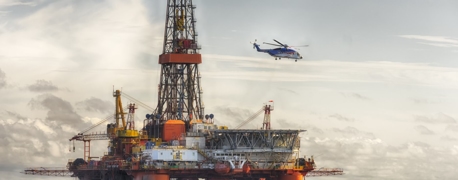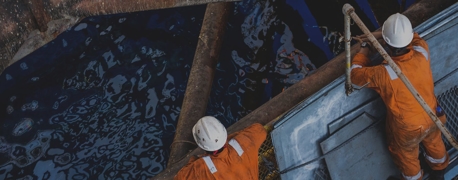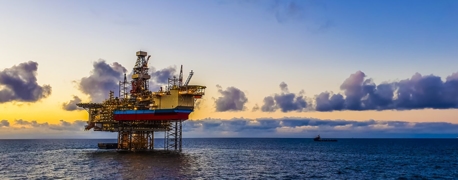What Oil Rigs Are in the Gulf of Mexico (Gulf of America)?

The Gulf of Mexico, recently renamed the Gulf of America in the United States by the Trump Administration, is a vast expanse of water bounded by the United States, Mexico, and Cuba that has long been a focal point for the offshore oil and gas industry. The area holds special significance for U.S. oil production and refinement, producing 14% of the total crude oil and 5% of the dry natural gas in the U.S. from federal offshore sources. Additionally, more than 48% of the country's petroleum refining capacity and 51% of its natural gas processing plant capacity are located along the Gulf Coast.
Since offshore drilling first began in the Gulf in 1942, approximately 6,000 oil and gas structures have been installed along the coast. Today, thousands of these structures remain in operation. When it comes to oil rigs, specifically, about 125 are still active. Some of these are mere meters from the shore, while others stand up to 250 miles into the Gulf. Their size and capacity varies, as well; there are single well caissons in 10 feet of water just as there are large facilities operating in water up to 10,000 feet deep.
Notable Oil Rigs in the Gulf of Mexico (Gulf of America)
Some notable oil rigs in the Gulf of Mexico (Gulf of America) include:
- Baldpate: Baldpate is an offshore compliant tower oil platform located 1,902 feet from the Louisiana coastline, operated and owned by Hess Corporation. It was the first freestanding compliant tower constructed, following the Lena platform. Baldpate holds the distinction of being the second tallest man-made structure in the water, after the Petronius oil platform.
- Bullwinkle: The Bullwinkle oil platform, standing at 1,736 feet, was a pile-supported fixed steel structure installed in 1988, with a total weight of 77,000 tons. At the time of its construction, it ranked as the fourth tallest freestanding structure in the world, surpassed only by the Warsaw Radio Mast, the CN Tower, and the Ostankino Tower. It was also the tallest structure in the U.S., exceeding the Sears Tower’s pinnacle by 6 feet. Located in Green Canyon Block 65, about 160 miles southwest of New Orleans, the platform is currently operated by QuarterNorth Energy, LLC.
- Mad Dog: Located about 100 miles south of Grand Isle, Louisiana, the Mad Dog platform is BP's only floating spar facility in the Gulf. It operates near the Mad Dog oil field, an offshore oil field with a capacity of approximately 100,000 barrels a day. The majority of the platform's single column, which stretches to 550 feet in length, is below the surface.
- Magnolia: Magnolia is an offshore oil drilling and production platform in the Gulf of Mexico (Gulf of America), designed as an Extended Tension Leg Platform (ETLP). At the time of its installation, it was the deepest ETLP globally, reaching a depth of 4,698 feet, surpassing the Marco Polo TLP by 390 feet. However, in March 2018, the Big Foot ETLP surpassed it with a depth of 5,180 feet.
- Mars: Mars is a permanent tension-leg platform (TLP) used for offshore drilling and production in the Gulf of Mexico (Gulf of America), situated in Mississippi Canyon blocks 762, 763, 806, 807, 850, and 851. Approved by the MMS in December 1992, production began on July 8, 1996. Shell acquired the leases in 1985 and 1988, and the platform operates as a joint venture between Shell Oil Company and BP, with Shell holding the majority ownership and overseeing operations. Located in a water depth of 2,940 feet, Mars is capable of producing 220,000 barrels of oil and 220 million cubic feet of gas daily.
- Petronius: Petronius is a deep-water compliant tower oil platform, constructed between 1997 and 2000 and located about 130 miles southeast of New Orleans, Louisiana. It is operated by Chevron. The platform features a compliant piled tower design, standing 2,100 feet tall from the sea floor to the tip of the flare boom. It was considered one of the tallest free-standing structures in the world until the Burj Khalifa surpassed it in 2010. The platform extracts around 60,000 barrels of oil and 100 million cubic feet of natural gas daily.
- Thunder Horse: The Thunder Horse oil field is a significant deep-water offshore oil field located in the Gulf of Mexico (Gulf of America), approximately 150 miles southeast of New Orleans, Louisiana. In early 2019, several major new oil discoveries were reported within the field. BP plc, along with a 25% stake from ExxonMobil, is leading the development of the field. It boasts the largest offshore production platform in the Gulf, with a processing capacity of 250,000 barrels of oil per day and 200 million cubic feet of natural gas per day. The field is estimated to contain more than 1 billion barrels of oil.
The Petronius Platform
The Gulf of Mexico (Gulf of America) is home to one of the largest oil rigs in the world. Constructed over three years, from 1997 to 2000, the Petronius platform is a testament to the advancements in offshore drilling technology and structural engineering. This fixed-compliant tower-type rig, with its staggering weight of 47,399 tons, showcases the colossal scale of modern offshore platforms. Designed to withstand the harsh marine environment, Petronius operates at an impressive depth of 1,754 feet, tapping into the rich oil reserves hidden beneath the Gulf's waves.
Types of Offshore Drilling in the Gulf
The Gulf of Mexico (Gulf of America) is characterized by a diverse range of drilling platforms and rigs designed to tap into the rich oil reserves beneath its waters. These operations are categorized based on the depth at which they occur, each with its unique challenges and technologies.
Some of the different types of drilling done in the Gulf of Mexico (Gulf of America) include:
- Nearshore drilling operations are conducted in relatively shallow waters, typically up to a depth of 500 feet. These areas are closer to the shore, often visible from land, and represent the early days of offshore drilling where the technological and logistical challenges were less formidable. Nearshore rigs can be fixed directly to the ocean floor, providing a stable platform for drilling operations. The proximity to land supports easier logistics and operational support, making nearshore drilling a less expensive and technologically demanding endeavor compared to its deeper counterparts.
- Deep-water drilling refers to operations conducted at water depths ranging from 500 to 5,000 feet. This category has seen significant growth over the past few decades, driven by advances in drilling technology and the depletion of more accessible nearshore reserves. Deep-water rigs are often semi-submersible platforms or drill ships that are not fixed to the seabed but remain in position through sophisticated dynamic positioning systems. The increased depth presents challenges, such as higher pressures, more complex logistics, and the need for advanced safety measures. However, the potential rewards are substantial, as deep-water regions can house large, untapped reserves of oil and gas.
- Ultra deep-water drilling pushes the boundaries of offshore oil and gas extraction even further, occurring at depths of over 5,000 feet. These operations require the most advanced technologies in the industry, including state-of-the-art drill ships and floating production, storage, and offloading (FPSO) units. The technical challenges are immense, from extreme pressures to low temperatures to the need for remote-operated vehicles (ROVs) for equipment installation and maintenance. Despite these challenges, ultra deep-water drilling offers access to some of the most promising oil and gas reserves in the Gulf, making it a crucial frontier for the energy sector.
Leading the U.S. Oil Industry: Why the Gulf of Mexico (Gulf of America) Matters
The Gulf of Mexico (Gulf of America) is one of the world's most significant regions for oil and gas extraction due to a combination of geological, economic, regulatory, and logistical factors. Beneath the Gulf's waters lie some of the most vast oil and gas fields in the world. The region's geological makeup, characterized by thick sedimentary basins, has provided the perfect conditions for the accumulation of oil and gas over millions of years. These reserves have not only been pivotal in meeting the growing energy demand but have also spurred economic growth and development across the Gulf Coast region.
What's more, the area is uniquely positioned as a hotspot for all three types of offshore drilling—nearshore drilling, deep-water drilling, and ultra deep-water drilling—and its proximity to major oil refineries and distribution centers along the Gulf Coast significantly reduces transportation costs and time. Moreover, favorable tax laws and regulatory environments in the surrounding states, including Alabama, Texas, and Louisiana, make it an attractive investment destination.
“Buying Land” in the Gulf
In the Gulf of Mexico (Gulf of America), the notion of "buying land" does not apply in the conventional sense. Instead, what occurs is a structured process where entities—typically corporations or consortia involved in the energy sector—acquire rights to explore and potentially extract oil and gas from specific areas of the seabed. This process is governed by a system of leases.
The leasing of offshore areas in the Gulf of Mexico (Gulf of America) for oil and gas exploration and production is managed by the U.S. Bureau of Ocean Energy Management (BOEM), a federal agency responsible for overseeing the sustainable development of the nation's offshore resources. BOEM organizes periodic lease sales, which are essentially auctions where eligible companies can bid on the rights to explore and develop certain tracts of the seabed for oil and gas resources.
Deep-Water Seismic Exploration: Essential Industry Roles
In the dynamic world of offshore oil and gas exploration in the Gulf of Mexico (Gulf of America), specialized roles—such as deep-water seismic developer, deep-water seismic surveyor, and deep-water seismic helper—are a critical part of the approximately 10,000 to 12,500 workers employed directly on oil rigs in the region. These positions are pivotal in the early stages of exploration, where understanding the geological underpinnings of the seabed is crucial for identifying potential oil and gas reserves.
But what exactly do these roles entail, and do they still exist today?
Deep-Water Seismic Developer
A deep-water seismic developer is involved in designing and implementing seismic data collection programs. Their work is foundational in acquiring accurate geological data from beneath the seabed. They develop methods of seismic exploration that can penetrate thousands of feet underwater, ensuring the data collected will provide critical information about potential hydrocarbon deposits. With the continuous evolution of technology and methodologies in seismic exploration, the demand for innovative deep-water seismic developers remains high.
Deep-Water Seismic Surveyor
The deep-water seismic surveyor plays a hands-on role in the data collection process. Utilizing sophisticated equipment, they conduct seismic surveys by sending acoustic waves into the seabed and recording the echoes that bounce back. This information is crucial for creating detailed maps of subsea geology. The role requires not just technical expertise in operating advanced seismic equipment but also a robust understanding of marine geophysics. Despite the advancements in autonomous and remote-operated technologies, the unique challenges of deep-water environments ensure that the role of a seismic surveyor remains relevant.
Deep-Water Seismic Helper
Supporting the surveyors and developers, deep-water seismic helpers are involved in the logistical and operational aspects of seismic exploration. They assist with equipment setup, maintenance, and data collection, ensuring that the seismic surveys run smoothly. While the role might not require as much specialized knowledge as developers or surveyors, it's a crucial entry point for those looking to start a career in offshore exploration. With ongoing exploration activities in the Gulf of Mexico (Gulf of America) and beyond, the need for deep-water seismic helpers continues to be significant.
The Current State of Deep-Water Seismic Roles
These roles are not only still in existence but are also evolving with ongoing technological advancements and the increasing complexities of deep-water exploration, such as a shift toward more sustainable and efficient exploration methods. As the oil and gas industry continues to push the boundaries of deep-water exploration, the demand for experienced seismic developers, surveyors, and helpers remains, driven by the ever-present challenge of safely and sustainably unlocking the energy resources hidden deep beneath the ocean's surface.
The Threat of Unplugged Oil & Gas Wells
Currently, there are hundreds of abandoned or out-of-use oil and gas structures in the Gulf of Mexico (Gulf of America). Although many rigs have been decommissioned and plugged properly, several others were left untouched. Some 14,000 inactive oil and gas wells remain uncapped in the Gulf and throughout Alabama, Louisiana, and Texas, posing a significant environmental risk to the waters and wetlands surrounding them. The concern is not just theoretical; uncapped wells can leak harmful substances, including oil and methane, into the ocean, threatening marine life, disrupting ecosystems, and contributing to water pollution.
The process of decommissioning and plugging these orphaned wells properly is both technically challenging and financially burdensome. It involves sealing the wells with cement and removing any remaining infrastructure to prevent leaks. However, due to the sheer number of inactive wells and the logistical difficulties of working in deep-water environments, the task is daunting. The financial responsibility for these decommissioning efforts often falls into a gray area, especially with wells owned by companies that have since gone out of business or have transferred ownership.
The Future of the Gulf
From the early days of offshore drilling in 1942 to the modern era of advanced deep-water exploration, the Gulf of Mexico (Gulf of America) has played a pivotal role in shaping the global energy landscape. But the Gulf's story is far from over. As the world grapples with the dual challenges of meeting energy demands and protecting our planet, this unique region will undoubtedly play a crucial role in navigating these complex waters.


